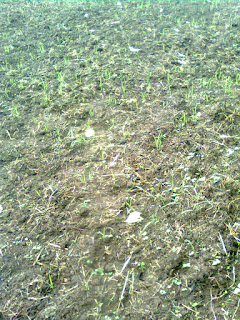Visited Manoj's zero budget farm in Kanjikode,Palakkad. I had visited this farm in 2008 and that time it was more at the begining stage and now it is a complete farm. He had started with chemical farming but he could make out that the fertility of the soil is loosing and expenses are becoming more. He was looking for alternative solution and finally adopted zero budget farming of Subash Palekar. His farm is around 12 acres and main crops are sugar cane, coconut and banana. He has 4 or 5 local cows and used to make Jeevamritham earlier to bring back the fertility. Now he is planning to pump cowdung and urine through out the farm. In one area of the farm he has coconut, banana, coco, glyrecedia, coffee, cardomom etc. This area has trenches and completely aligned with Palekar's methods. He is also planning to introduce nutmeg and according to him with sufficient mulching watering can be reduced. After intercropping the coconut yield also has increased and he gets banana bunches with average weight of 8Kgs.
Trees need mositure not water, aeration is an important factor in getting good yield. He says if tea is given in a glass you can drink it, but if it is given in a pot it can not be and same is the case with plants. His main problem now is water logging and it reduces the yield so he is looking for solutions for that. He is using the same sugar cane variety used by Krishnappa Dasappa Gowda of Mysore, but he doesn't get the same yield, so he feels sunlight is one of the major factor in deciding the yield. He tills the land and sow seeds of many legumes to make the land fertile. I felt if he can achieve the same without tilling there is a chance that fertility increases much and also water logging also may be reduced with more aeration for the soil. There are earthworms all around the farm. His farm has got organic certification from Indocert and it takes 3 years to get the certification. The cost of this certification is 9000/- per year. His main farm produce is coconut oil, sugar cane jaggery and banana.
Here are some photos of his farm -
Request to visitors
I have been giving Manoj's number to people who request for that. Recently I learnt that Manoj is very busy with farm work and marketing his products, a farmer always struggles to make a living, since there is less support from society and government. So probably when you call him to visit, please see if you can buy some of his products during the visit so he also will find it useful. This is just my opinion, never talked to him about this.






















































